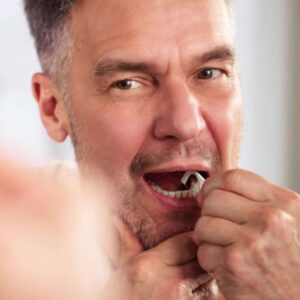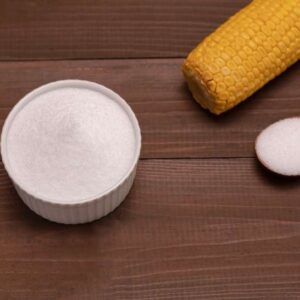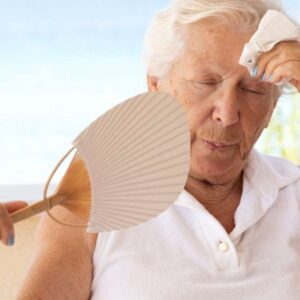
WARNING: There Is a Killer in Your Shower
- You definitely don’t want a case of these vapors
- Find out what your showerhead isn’t doing for you
- Take your vitamins…in the shower?
Dear Reader,
I love to shower.
The soothing sound of a running shower and the feel of warm water washing away all of the troubles of the day or night. It really is one of the best ways to start or finish my day.
And it seems I’m not alone. The average American showers at least seven times a week — beating out other countries like the U.K. and Japan, where the average is only five showers per week. 1
These seven showers total up to about an hour spent in the shower per week.
Somehow, I don’t really believe this statistic — I know plenty of folks (myself included) who can spend an hour a day in the shower or soaking in the tub.
In fact, Americans love shower time so much we use over 1 trillion gallons of water every year for our hygienic rituals.2
But there is a great danger in all of this shower time, and it isn’t just frivolous water waste. It’s the health-hazardous chemicals our water supply is laced with that make these seemingly harmless aquatic indulgences wreak havoc on your well-being, and could even lead to deadly diseases like cancer and heart disease.
And while you may think your current shower filter (if you have one) is protecting you from harmful toxins, there is a great chance it isn’t.
Well, unless you only take cold showers.
We will dive further into the health dangers and talk about a shower head so powerful it can protect you from poisonous chemicals in just a bit. First, let’s find out what’s pouring out of your shower head.
![]() Toxic Wash
Toxic Wash
If you ever cranked your shower up to extra hot and left the bathroom for a minute, then you have probably noticed the faint smell of swimming pool in the room when you return.
There is a reason for this — and it’s disturbing.
Your now steamy bathroom full of chlorine vapor — the same corrosive chemical used to keep swimming pools hygienic.
As you may have heard before, chlorine isn’t just used to keep the water are the community pool sanitary. It’s also used treat bacteria in municipal water supplies — the water that is directly pumped into your home. The problem is while this chlorine is very effective at killing germs, it’s also extremely toxic to humans.
And the worst part — your daily shower is trickling this toxic substance directly on your largest organ — your skin.
Research published in the American Journal of Epidemiology and Journal of Occupational and Environmental Medicine suggests cancer risks from exposure to chlorinated water is more likely due to showering and bathing rather than drinking chlorinated water.2,3
One reason for this is chloroform — yep, chloroform — the same stuff serial killers used to knock people out with in the 19th century.
When chlorine combines with organic matter, it forms chloroform.
And while it’s probably not enough to take you down like an 1800s killer, it is a known carcinogen and highly toxic when it is inhaled or makes contact with the skin.4
In fact, a 10-minute shower can produce a single dose of chloroform equal to that of drinking two liters of chlorinated water! 5,6
The problem is when you drink water, the body can filter out the chlorine from the water, but when you inhale it in gas form, it goes directly into your bloodstream.
This means even if you are filtering your drinking water, you are still getting a heavy and dangerous dose of chlorine in your shower.
Dr. Lance Wallace of the Environmental Protection Agency reports,
Showering is suspected as the primary cause of elevated levels of chloroform in nearly every home because of the chlorine in the water.7
However, the health dangers of chlorine don’t stop at cancer. Chlorine exposure may also cause:
- Hardened arteries
- Difficulty metabolizing cholesterol
- Free radical exposure
- Irritation of the nose, throat, lungs, and eyes.
Not to mention it causes itchy, flaky skin and scalp that can be an endless source of irritation and discomfort.
And then there are chloramines.
Chloramines are derivatives of ammonia and chlorine used as a water disinfectant instead of chlorine.
Just like ordinary chlorine, chloramines cause cancer and other health issues, but with two major differences — they are even more even more toxic than chlorine when it comes to lung cancer and they are much harder to remove from shower water.
In fact, popular carbon shower filters are almost useless when it comes to filtering both chlorine and chloramines because they don’t work well with warm water.
But don’t worry showers don’t have to be cold to avoid these dangers. There is a natural substance that can neutralize 99.9 percent of the chlorine and chloramines in your shower water — and the best news— it’s the least toxic of known de-chlorinators.
Actually, it’s a vitamin.
![]() Power in the Shower
Power in the Shower
Vitamin C, to be exact.
That’s right — good ole vitamin C doesn’t just keep colds away — it keeps the chloroform away too!
Vitamin C, also known as ascorbic acid, is a proven chlorine buster, but that’s not all: It can protect you in the shower — vitamin C also neutralizes chloramines.
In fact, the San Francisco Public Utilities Commission reports that vitamin C is the only substance that removes chloramines from municipal water. Here is what they had to say about it:
Vitamin C (ascorbic acid) has recently been included in AWWA Standard (AWWA, 2005b) as one of the methods for dechlorination of disinfected water mains. SFPUC and other utilities have used vitamin C for dechlorination prior to environmental discharges of chlorinated and chloraminated water. Since ascorbic acid is weakly acidic, the pH of water may decrease slightly (Tikkanen et al., 2001). Ascorbic acid has been used for a long time as one of the dechlorinating agents for preservation of chlorinated or chloraminated water samples for laboratory analysis.
Of the vitamin C filters available, I recommend the Sonaki brand. I tried a Sonaki Rain shower head for a few weeks in my apartment and found that not only was the swimming pool stench gone, but it also made my skin and hair feel softer.
Sonaki filters are transparent. This means you can see when the vitamin C has run out. They typically last about two–four months, depending on how frequently you shower, and are easy to replace.
Click here to learn more about the Sonaki vitamin C shower head.
If you’ve used a vitamin c shower filter before, tell me how it worked for you! nmoore@lfb.org
Live well,

Natalie Moore
Managing editor, Living Well Daily
Ed. Note: Please send your feedback: nmoore@lfb.org – and click here to like us on Facebook.
Sources
[1] Save Water and Energy by Showering Better
[4] CHLOROFORM
[5] Chloroform exposure and the health risk associated with multiple uses of chlorinated tap water.
[6] Ingestion, Inhalation, and Dermal Exposures to Chloroform and
Trichloroethene from Tap Water
[7] #50 — Shower Water Toxicity
[8] Sonaki Vitamin C Shower Filter…How it Works!
[9] QUESTIONS REGARDING CHLORINE AND CHLORAMINE REMOVAL FROM WATER
Written By Natalie Moore
Natalie Moore is a dedicated health researcher with a passion for finding healthy, natural, and science-based solutions. After a decade of direct healthcare experience in western and natural medicine, she was involved in public health research before joining Living Well Daily.
View More Free Articles
Stop Obsessing Over Diet Trends
Can we stop with the endless diet debates already? Every other week there’s a new headline shouting about which diet is best for weight loss, heart health, or diabetes. Paleo, keto, low-carb, high-protein… it’s exhausting. And now, a new meta-analysis is out comparing the Mediterranean diet, the DASH diet, and something called AHEI (that’s “Alternative...
A New Reason to Ditch Processed Junk
If you’ve ever walked the inside aisles of your local grocery store and thought, “This is all just junk,” your instincts were spot on. A new study published in the journal Thorax just added another red flag to the list of dangers linked to ultra-processed food—a 41 percent higher risk of lung cancer. That’s right....
When Being Winded on Stairs Is Serious (And When It Isn’t)
I had an athlete visit me recently because he experienced shortness of breath while climbing stairs. He is in great shape, so he was worried about what it might mean. “Doc,” he said, “I run five miles three times a week. Why am I huffing and puffing after two flights of stairs?” His concern is...
Study EXPOSES Hidden Danger Lurking in Your Car
We think of our homes and cars as safe havens. But according to a startling new study, they may be flooding your lungs with microscopic plastic particles—every single day. Researchers in France recently found that adults inhale an average of 68,000 microplastic particles daily from indoor air alone. To put that in perspective, that’s about...
Mailbag: Is Modern Food Making You Snore?
“What can cause snoring, and is there a way to correct this issue?” —Seeking Silence Hi Seeking, Snoring happens when the soft tissues in your throat relax and vibrate as air passes through during sleep. While several factors can cause snoring—from sleep position to nasal congestion—I want to share one trigger that might surprise you....
Simple Food Swap SLASHES Dementia Risk 28%
Let’s be honest… who would jump at the chance to cut their dementia risk by 28 percent. And no, you don’t need to run marathons, survive on broccoli, or learn to play the zither (whatever that is) to make it happen. All it takes is one easy swap—something that’s probably already in your refrigerator. Researchers...
This SMART Floss Exposes Hidden Health Danger
Scientists have created dental floss that doesn’t just clean between your teeth—it also tracks your stress while you’re flossing. Now, I know what you’re thinking… “Great—now even flossing is going to stress me out by telling me how stressed I am.” But this fascinating new tool from Tufts University could be a game-changer for understanding...
Is This "Safe" Sweetener Damaging Your Brain?
The headlines are alarming… “Popular Sugar Substitute Linked to Brain Cell Damage” and “Erythritol Could Damage Critical Brain Barrier” are just two of the dozens I’ve spotted recently. But before you toss every sugar-free product in your pantry, let’s take a closer look at what this study actually shows—and what it doesn’t. The latest research...
This Summer Threat Could SPIKE Your Blood Sugar
Picture this… It’s another scorching hot summer day. You crank up the air conditioning while watching the weather forecast, which predicts yet another “record-breaking” heat wave. It’s starting to feel like just another miserably uncomfortable summer. But what you might not realize is that—if you have diabetes—those rising temps could do far more damage to...
Move Over Yogurt—5 Foods That Pack MORE Probiotics
Let’s talk about your gut. The microbiome is the collection of trillions of bacteria and other tiny organisms that live in and on your body—especially in your gut—and help keep you healthy. I’ve written often about how vital it is to maintain a healthy microbiome. And you might have dutifully added yogurt to your shopping...









